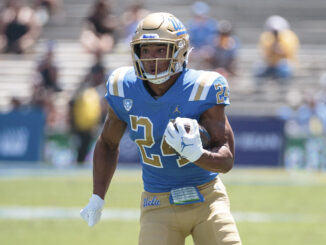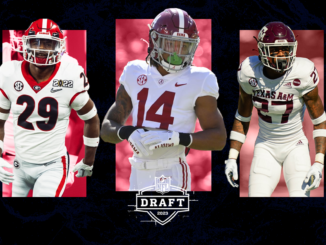This year’s interior offensive line class might not possess a true bona fide star, but the depth and variety available certainly makes it an intriguing group. Here are my top ten interior offensive linemen in the 2023 NFL Draft.
You can also download our free 2023 NFL Draft Guide, with over 130 in-depth prospect profiles!
1. O’Cyrus Torrence, Florida (6-5, 330, Senior)

Pros: Torrence showcases heavy hands and he is able to lock out and sustain so well. The power through his frame is outstanding and he is easily able to displace defenders in the running game. He also shows a stout anchor when faced with power in pass protection. He is a smart processor who is able to quickly react to stunts and twists and has four seasons of experience as a starter during his time at Louisiana and Florida. Torrence didn’t allow a single sack on his 1,501 pass blocking snaps and gave up just one hit.
Cons: Torrence comes with some athletic limitations. He isn’t the most mobile of linemen and will struggle if asked to play in space. His lateral agility is less than ideal and mean he is unlikely to be a great fit in a zone-heavy scheme. There were also a number of occasions on tape where he really struggled to locate and latch onto defenders at the second level. Torrence has a frustrating tendency to duck his head into blocks, something that will be exploited by NFL defensive linemen.
Projection: 2nd round
2. Steve Avila, TCU (6-4, 332, rs-Senior)

Pros: Avila possesses a good combination of size and athleticism for an offensive lineman. His anchor is impressive when he is tasked with containing power rushers, but he also has the necessary foot quickness and lateral agility to mirror more athletic pass rushers. This meant that he was rarely phased in pass protection, allowing a pressure on just 1.1% of his dropbacks in 2022. He also offers positional versatility, having started at both guard spots as well as center.
Cons: Avila needs to work on his hand usage to maximise his potential. At present it is noticeably inconsistent, both in terms of timing and placement. This is part of the reason that he struggles to sustain his blocks when climbing to the second level. There were also a number of times on tape where he was seemingly fooled by stunts and twists and allowed a free rusher to get to his quarterback. Avila needs to do a better job of maintaining good pad level when engaging with defenders.
Projection: 2nd round
3. Joe Tippmann, Wisconsin (6-6, 313, rs-Junior)

Pros: Tippmann is an outstanding athlete who moves effortlessly in space. This makes him a real asset on wide zone runs and when asked to get out in front as a lead blocker on screens. He also has a good power profile, showing the ability to uproot defensive linemen on drive blocks in the running game. This combination of power and movement skills makes him very effective as a pulling blocker. Tippmann also has the mean streak you want along the offensive line and loves to get his opponents on the deck.
Cons: At 6’6″, Tippmann is very tall for a center. Unsurprisingly this causes issues with leverage and plenty of defensive tackles were able to get up and under his pads. There were also times where he would lose balance due to his tendency to lunge at opponents. His hand technique needs work too as he is often late in making contact with his opponent. When this happens he struggles to quickly drop his anchor and is easily walked back into the pocket. Tippmann has played almost exclusively at center in college.
Projection: 2nd round
4. Luke Wypler, Ohio State (6-3, 303, rs-Sophomore)

Pros: Wypler is an incredibly smooth athlete who displays impressive short area quickness. This makes him a real asset as a zone blocker where he looks excellent climbing to the second level to wall off linebackers. He has also shown the ability to be used effectively as a puller on gap scheme concepts. Wypler’s hand placement is very good for such a young player and he is able latch and steer effectively. He is reliable in pass protection too, allowing one sack in two seasons as a starter.
Cons: Wypler lacks ideal size for an interior lineman. He has a slight frame that clearly causes issues when he is faced with power rushers. You don’t really see much in the way of anchor ability on tape, and that is likely to be even more of a concern at the next level when he is facing NFL competition. There will also be concerns surrounding his length. Wypler has 31.6″ arms, which rank in just the 11th percentile amongst centers. He has also played exclusively as a center in college.
Projection: 2nd round
5. John Michael Schmitz, Minnesota (6-4, 301, rs-Senior)

Pros: Schmitz is one of the most experienced players in the draft, coming out as a sixth-year senior. He spent four of those seasons as a starter for the Golden Gophers and that experience shows on tape. He is a very smart player who is comfortable setting protections and passing off stunts and twists. Schmitz is also very technically refined as a zone blocker and looks effortless when asked to execute reach blocks on wide zone runs. He also possesses a very solid anchor in pass protection.
Cons: Whilst Schmitz is a good technician, he isn’t exactly a special athlete. He also has a few frustrating tendencies that he needs to clean up. The first of these is his over-aggression, which sees him leave gaps for smarter defenders to exploit. He also appeared to struggle when asked to locate and sustain blocks at the second level. There is also the fact that Schmitz is one of the older prospects in the draft, having turned 24 years old a month before the draft.
Projection: 2nd round
6. Cody Mauch, North Dakota State (6-5, 302, rs-Senior)

Pros: Mauch began his college career at tight end and you can tell when you turn on his tape. He is a phenomenal athlete with movement skills that you rarely see along the offensive line. His quickness out of his stance is impressive and he looked comfortable when asked to mirror in pass protection, allowing just two sacks in his college career. He is a mauler in the run game, with the ability latch and sustain. Mauch also displays the competitive toughness to finish his blocks.
Cons: Mauch played almost exclusively as an offensive tackle during his time in college, but a noticeable lack of length means he is unlikely to be able to stick there at the NFL level. The worry is that he has a skinny frame which is going to be more of a concern against bigger defensive linemen along the interior. Mauch also needs plenty of work on his pass protection technique and can get over-aggressive and lose his balance. He is also an older prospect, turning 25 before the end of his rookie season.
Projection: 3rd round
7. Andrew Vorhees, USC (6-6, 310, rs-Senior)

Pros: Vorhees has tonnes of experience under his belt, with almost 3,500 career snaps to his name. He has been starting for the Trojans since Sam Darnold was their quarterback and has played over 1,000 snaps at both guard spots, as well as a decent helping at left and right tackle. As you might expect for such an experienced lineman he consistently looks calm and collected when faced with stunts and twists. He also shows good power at the point of attack and a tremendous anchor to neutralise power.
Cons: Vorhees is nothing special from an athletic standpoint and might not be a fit in every offensive scheme as a result. He lacks the foot quickness you want along the offensive line and that does lead to some issues when he is challenged laterally by more agile defensive linemen. He is also tall for a guard and will often be out-leveraged by opponents. Despite his experience his hand placement is still erratic. He is also already 24 years old and due to miss a large portion of his rookie season after suffering a torn ACL at the Combine.
Projection: 3rd round
8. Ricky Stromberg, Arkansas (6-3, 306, Senior)

Pros: Stromberg is a very well-rounded athlete, possessing the explosiveness and lateral quickness that teams want in their offensive linemen. He pairs this with the anchor ability to successfully contain bull rushes in pass protection. Stromberg is also one of the more cerebral linemen in the class, looking comfortable when setting protections and reacting to blitzes. He also brings four years of starting experience in the SEC to the table.
Cons: Stromberg has a tendency to bend at the waist rather than the knees. This, coupled with his tendency to duck his head into contact, can lead to issues with him getting himself out of position and losing his balance. He also stops his feet on contact too often and needs to be better at continuing to drive defenders off the ball. His hands are often wide and he needs to improve his ability to land within the strike zone.
Projection: 3rd round
9. Emil Ekiyor, Alabama (6-4, 314, rs-Senior)

Pros: Ekiyor is a strong physical presence along the offensive line. He showcases good strength and the power required to create movement in the running game. He pairs this with an aggressive demeanour too and he will consistently play to the whistle in an effort to finish his blocks. His first step quickness is good and projects well to the next level. Ekiyor is also entering the NFL with tonnes of experience, logging over 2,700 snaps during his career in the SEC.
Cons: Ekiyor’s desire to finish his blocks is commendable, but on a number of occasions it led to him getting over his toes and losing his balance. He also lacks ideal size for an interior lineman at the NFL level and may struggle when asked to contain bigger defensive linemen. He doesn’t have great lateral quickness either and looked a little clunky when asked to redirect. Despite his experience, Ekiyor is often still too slow with his hands and will let opponents get inside his frame.
Projection: 3rd round
10. Olesegun Oluwatimi, Michigan (6-3, 309, rs-Senior)

Pros: Oluwatimi is an intelligent center prospect who looks comfortable being asked to set protections and communicate with the rest of his offensive line. He also shows good independent hand usage that allows him to reset and take control of blocks. He possesses the requisite core strength to translate to the NFL too, with enough anchor ability to neutralise power rushers. His competitive toughness is also excellent and he plays the game with a physical and aggressive demeanour.
Cons: Oluwatimi has some limitations in terms of his athletic ability and can struggle when tested laterally by more athletic defenders. He isn’t exactly the strongest either and does not have the play strength to consistently displace opponents in the running game. Oluwatimi has very small hands and this limits his ability to latch and sustain. He also turns 24 years old before the start of his rookie season and played exclusively a center in college.
Projection: 4th round


